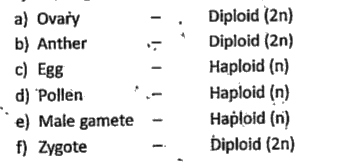Identify each part in a flowering plant and write whether it is haploid (n) or diploid (2n).
(a) Ovary ------------------------
(b) Anther ----------------------
(c) Egg ---------------------
(d) Pollen ----------------------
(e) Male gamete ---------------------
(f) Zygote -------------------------Solution in Telugu
Topper's Solved these Questions
- MODEL PAPER 4 BOOK - VGS PUBLICATION-BRILLIANTCHAPTER - MODEL PAPER 4 EXERCISE - SECTION -C
3 Videos
- MODEL PAPER 4 BOOK - VGS PUBLICATION-BRILLIANTCHAPTER - MODEL PAPER 4 EXERCISE - SECTION -C
3 Videos
- MODEL PAPER 3BOOK - VGS PUBLICATION-BRILLIANTCHAPTER - MODEL PAPER 3EXERCISE - SECTION - C
3 Videos
- MODEL PAPER 5BOOK - VGS PUBLICATION-BRILLIANTCHAPTER - MODEL PAPER 5EXERCISE - SECTION - B
6 Videos
Similar Questions
Explain different types of Racemos inflorescences.
View SolutionExplain different types of Racemos inflorescences.
View SolutionExplain how stem is modified variously to perform different functions.
View SolutionExplain "Rivet popper" hypothesis.
View SolutionHow many given structures are haploid ? Ovary, anther, egg, pollen, male, gamete, zygote
View SolutionIdentify each part in a flowering plant and write whether it is haploid (n) or diploid (2n). (a) Ovary_____________________ (b) Anther_______________ (c) Egg_________________(d) Pollen ____________ (e) Male gamete____________ (f) Zygote____________
View SolutionIdentify each part and write whether it is haploid (n) or diploid (2n), in a flowering plant. (a) Ovary (b) Anthre (c) egg (d) pollen (e) male gamete (f) zygote
View Solutionप्रत्येक पुष्पीय पादप के भाग को पहचाननें तथा कि वह अगणित (न) है या द्विगुणित (2n) । (क) अंडाशय ____________________ (ख) परागकोष ____________________ (ग) अंडा (या डिम्ब) ____________________ (घ) पराग ____________________ (च) नर युग्मक ____________________ (छ) युग्मनज ____________________
View Solutionप्रत्येक पुष्पीय पादप के भाग को पहचानिए तथा लिखिए कि वह अगुणित (n ) है या द्विगुणित (2n ) -
(क) अण्डाशय, (ख) परागकोश, (ग) अण्ड का डिम्ब , (घ) परागकण , (ड़) नरयुग्मक, (च) युग्मनज ।
View Solutionनिम्नलिखित में बताएँ कि कौन अगुणित है और कौन द्विगुणित:
(a) अण्डाशय
(b) परागकोश
(c) अण्डा
(d) पराग
(e) नर-युग्मक
(f) युग्मनज।
View SolutionIdentify each part in a flowering plant and write whether it is haploid (n) or diploid (2n).
(a) Ovary ______
(b) Anther _________
(c) Egg _________
(d) Pollen __________
(e) Male gamete ________
(f ) Zygote _________
View SolutionIdentify each part and write whether it is haploid (n) or diploid (2n), in a flowering plant.
(a) Ovary (b) Anther (c) egg (d) pollen (e) male gamete (f) zygote
View SolutionIdentify each part in a flowering plant and write whether it is haploid (n) or diploid (2n). (a) Ovary ------------------------ (b) Anther ---------------------- (c) Egg --------------------- (d) Pollen ---------------------- (e) Male gamete --------------------- (f) Zygote -------------------------
View SolutionIdentify the part of each flowering plant and write whether it is haploid (n) or diploid (2n) (a) ovary (b) anther (c) egg (dub) (d) pollen (f) male gamete (g) zygote
View SolutionIdentify each part in a flowering plant and write whether it is haploid (n) or diploid (2n) Anther , ovary, egg, pollen, zygote , male gamete.
View SolutionIdentify each part in a flowering plant and write whether it is haploid (n) or diploid (2n).
(a) Ovary_____________________ (b) Anther_______________
(c) Egg_________________(d) Pollen ____________
(e) Male gamete____________ (f) Zygote____________
View Solution

